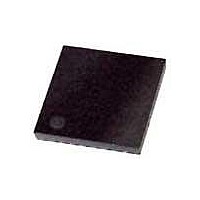ATA5428-PLQW80 Atmel, ATA5428-PLQW80 Datasheet - Page 26

ATA5428-PLQW80
Manufacturer Part Number
ATA5428-PLQW80
Description
RF Transceiver ASK/FSK Transceiver 434 and 868MHz
Manufacturer
Atmel
Datasheet
1.ATAB5428-8-WB.pdf
(100 pages)
Specifications of ATA5428-PLQW80
Wireless Frequency
226 KHz, 237 KHz
Interface Type
4-Wire SPI
Noise Figure
7 dB
Output Power
10 dBm
Operating Supply Voltage
2.4 V to 3.6 V
Maximum Operating Temperature
+ 85 C
Mounting Style
SMD/SMT
Package / Case
QFN-48
Maximum Data Rate
20 Kbps
Minimum Operating Temperature
- 40 C
Modulation
ASK, FSK
Lead Free Status / RoHS Status
Lead free / RoHS Compliant
26
ATA5423/ATA5425/ATA5428/ATA5429
C
enter the steep region of pulling versus load capacitance where there is a risk of an unstable
oscillation.
To ensure proper start-up behavior the small signal gain, and thus the negative resistance, pro-
vided by this XTO at start is very large; for example, oscillation starts up even in worst case with
a crystal series resistance of 1.5
approximately given by
with Z
Z
Z
Z
XTAL2 with typically 19 mS at 25°C.
With f
tance of about 2 k . The worst case for technological, temperature and supply voltage variations
is then for C
Due to the large gain at startup, the XTO is able to meet a very low start-up time. The oscillation
start-up time can be estimated with the time constant
After 10
High if the amplitude is large enough. This sets N_RESET to High and activates the CLK output
if CLK_ON in control register 3 is High (see
VSOUT and DVCC voltage also have to be fulfilled (see
To save current in IDLE and Sleep modes, the load capacitors are partially switched off in these
modes with S1 and S2, as seen in
It is recommended to use a crystal with C
C
Lower values of C
higher values of C
Re Z
1
3
3
0
0
=
consists of crystals C
= –j/(2
of the XTAL has to be lower than C
= 1.0 pF to 2.2 pF.
= –j/(2
-----------------------------------------------------------------------------------------------------------
4
XTOcore
XTO
1
, Z
2
2
= 13.5 MHz, gm = 19 mS, C
to 20
as complex impedances at pin XTAL1 and XTAL2, hence
0
=
f
2
m
2.2 pF always higher than 1.5 k
Re
f
f
C
XTO
XTO
m
m
an amplitude detector detects the oscillation amplitude and sets XTO_OK to
m
Z
----------------------------------------------------------------------------------------------------- -
1
(up to 15 fF) can also be used, this has only little influence on pulling.
can be used, this increases the start-up time slightly. Lower values of C
2
Re Z
Z
C
Z
C
0
3
1
0
in parallel with an internal 110 k resistor hence
L1
+
) /110 k , gm is the internal transconductance between XTAL1 and
+
) + 5 and Z
Z
Z
XTOcore
2
2
+
Z
Z
3
3
Figure
k
+
+
+
Z
Z
R
1
at C
1
L
m
Lmin
= 9 pF, and C
2
Z
Z
= –j/(2
4-2.
0
/2 = 3.7 pF for a Pierce oscillator type in order to not
2
2
Table
2.2 pF with this XTO. The negative resistance is
m
g
Z
m
= 3.0 fF to 7.0 fF, C
3
7-7). Note that the necessary conditions of the
g
m
0
f
= 2.2 pF, this results in a negative resis-
XTO
Figure 4-2
C
L2
) + 5 .
and
LN
= 9 pF, R
Figure
5-1).
4841D–WIRE–10/07
m
< 120
and
0
or















